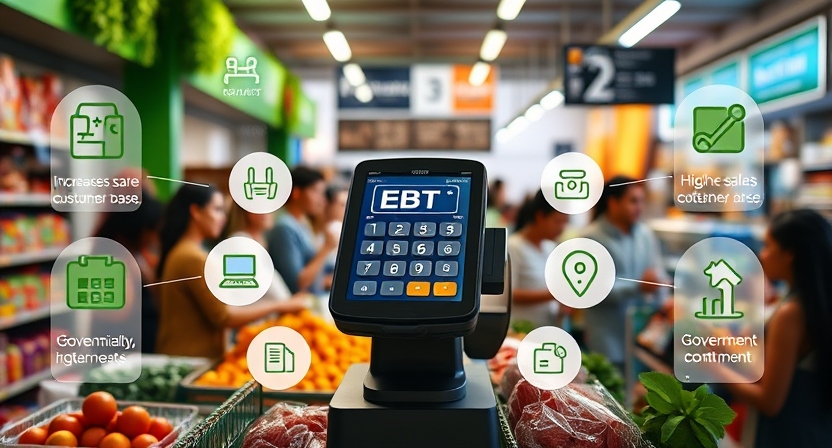
By get-ebt December 16, 2024
The rise of Electronic Benefits Transfer payments has presented small businesses with an incredible opportunity to reach a wider customer base while fostering community support. By embracing EBT payments, small businesses can not only increase revenue but also make a positive social impact. This article will explore the advantages of accepting EBT payments, how to set up this payment method, and practical tips for maximizing its potential.
Understanding EBT Payments and Their Importance

Electronic Benefits Transfer payments are a government-issued method of delivering benefits like the Supplemental Nutrition Assistance Program to eligible recipients. Instead of paper vouchers, funds are loaded onto a plastic card that works like a debit card. Recipients can use their EBT cards to purchase eligible food and grocery items at authorized retailers.
Small businesses, particularly local grocery stores, farmers’ markets, and convenience shops, can greatly benefit from accepting EBT payments. Here’s why:
-
-
1.Expanding the Customer Base
According to the USDA, more than 40 million Americans participate in the SNAP program annually. Accepting EBT payments opens your business to a vast segment of the population that relies on these benefits for their essential purchases.2.Strengthening Community Ties
Supporting customers who depend on EBT fosters goodwill and strengthens your business’s role as a trusted community resource. It demonstrates social responsibility and builds loyalty among customers who appreciate your inclusive approach.3.Increased Revenue Opportunities
EBT users often prioritize shopping at businesses where they can use their benefits. By accommodating this payment option, you attract more foot traffic, which can translate into higher sales, not just for eligible items but also for non-EBT purchases made by accompanying customers.
-
Accepting EBT payments isn’t just about business growth; it’s also about making a meaningful impact by serving an underserved community.
The Process of Setting Up EBT Payments

Transitioning to accept EBT payments involves a straightforward process but requires careful planning.
Here’s how small businesses can get started:
1.Apply for SNAP AuthorizationThe first step is to become an authorized SNAP retailer. Visit the USDA’s Food and Nutrition Service website to submit an application. You’ll need to provide details about your business, including its location, types of products sold, and proof of compliance with state regulations.
-
-
2.Obtain EBT Equipment|
Once approved, you’ll need equipment that can process EBT transactions. Some payment processing solutions integrate EBT with existing systems, while others require separate terminals. Research vendors that offer cost-effective and user-friendly options.3.Train Staff
Educate your team about how EBT transactions work, including which items are eligible for purchase and how to address customer questions. Clear signage can also help customers navigate their EBT usage smoothly.4.Market Your New Payment Option
Let your community know you accept EBT payments. Use signage, social media, and partnerships with local organizations to spread the word.
-
Setting up EBT payments may require an initial investment, but the long-term benefits, including customer loyalty and increased sales, far outweigh the costs.
Benefits of Accepting EBT Payments for Small Businesses

Studies show that businesses accepting EBT often see an uptick in sales. SNAP recipients shop more frequently and spend more at locations where they can use their benefits. This increase in revenue can be pivotal for small businesses.
Not all small businesses accept EBT payments. By offering this option, you distinguish yourself from competitors and attract loyal customers who prioritize convenience and accessibility.
Accepting EBT payments demonstrates that your business values inclusivity and supports local families. This community-focused approach enhances your reputation and can lead to positive word-of-mouth referrals.
-
-
4.Improving Cash Flow
EBT payments are processed electronically, ensuring quicker transactions and reducing the risks associated with handling cash. This streamlined process improves operational efficiency and security.
-
By recognizing and leveraging these benefits, small businesses can create a sustainable growth strategy while making a meaningful impact on their communities.
Addressing Common Challenges with EBT Payments

Despite its many advantages, incorporating EBT payments into your business may come with challenges. Understanding these hurdles and preparing solutions can help ensure a seamless transition.
1.Initial Setup Costs
Purchasing or upgrading payment processing equipment can be an upfront expense. However, many states offer grants or low-cost programs to help small businesses acquire the necessary technology.
-
-
2.Understanding Eligible Items
EBT benefits are restricted to specific categories, primarily food and grocery items. Non-food items like alcohol, tobacco, and prepared foods are not eligible. Clear staff training and proper signage can prevent confusion at checkout.3.Staying Compliant
Businesses must adhere to strict rules and reporting requirements to maintain SNAP authorization. Regularly reviewing guidelines and conducting internal audits can help avoid potential issues.4.Customer Education
Some customers may be unfamiliar with how to use their EBT cards. Providing a welcoming environment and clear instructions can help ease the process for new users.
-
By addressing these challenges proactively, small businesses can fully embrace the benefits of accepting EBT payments while maintaining compliance and customer satisfaction.
Practical Tips for Maximizing EBT Payment Potential
To truly thrive by accepting EBT payments, small businesses should adopt strategies that maximize their impact:
By adopting these strategies, small businesses can unlock the full potential of EBT payments and position themselves as essential community resources.
Conclusion
Accepting EBT payments is a game-changer for small businesses, offering a unique blend of financial growth and community impact. By understanding the setup process, addressing challenges, and implementing strategic practices, businesses can thrive in today’s competitive landscape. Embracing EBT payments isn’t just about increasing revenue—it’s about fostering inclusivity and building stronger ties within your community.
If you’re a small business owner, consider taking the leap to accept EBT payments. It’s an investment in your business’s future and an opportunity to make a meaningful difference in the lives of your customers. With the right approach and tools, you can turn this payment option into a catalyst for sustainable success.